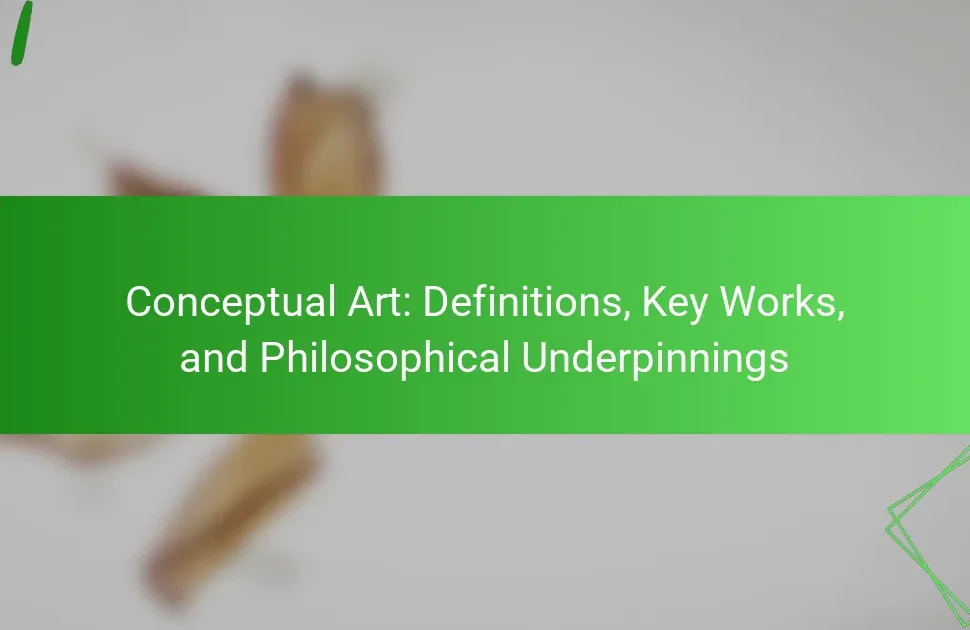Minimalism promotes mental clarity and emotional well-being by reducing excess and focusing on what truly matters. This article explores the core principles of minimalism, highlights notable artists like Donald Judd and Agnes Martin, and examines key aesthetic features such as clean lines and limited color palettes. Additionally, it discusses cultural interpretations and the challenges faced by minimalist artists.

What are the core principles of minimalism?
The core principles of minimalism focus on simplicity, functionality, and intentionality. Minimalism emphasizes reducing excess to highlight essential elements, fostering clarity and purpose in design and lifestyle choices. Key aspects include the belief in “less is more,” prioritizing quality over quantity, and creating spaces that promote peace and mindfulness. By stripping away distractions, minimalism encourages individuals to appreciate what truly matters in their lives.
How does minimalism promote simplicity in design?
Minimalism promotes simplicity in design by emphasizing essential elements and eliminating distractions. This approach enhances user experience and clarity. Notable attributes of minimalism include clean lines, open spaces, and a limited color palette. These features create a harmonious aesthetic that focuses on functionality and purpose. By removing excess, minimalism invites users to engage more deeply with the content.
Why is functionality prioritized in minimalist art?
Functionality is prioritized in minimalist art to emphasize simplicity and clarity. This approach strips away excess, allowing the viewer to focus on essential elements. Minimalist artists like Donald Judd and Agnes Martin highlight how form and function coexist harmoniously. By prioritizing functionality, minimalist art invites deeper contemplation of the artwork’s meaning and purpose, fostering a more intimate connection between the viewer and the piece.

Which notable artists have shaped the minimalist movement?
Notable artists who shaped the minimalist movement include Donald Judd, Agnes Martin, Dan Flavin, and Frank Stella. Each artist contributed unique perspectives, emphasizing simplicity and form. Donald Judd is known for his geometric sculptures, while Agnes Martin focused on subtle color and line. Dan Flavin utilized fluorescent light as an artistic medium, and Frank Stella’s work often features bold geometric patterns. Their collective influence defined minimalist aesthetics and principles.
What contributions did Donald Judd make to minimalism?
Donald Judd significantly shaped minimalism through his emphasis on simplicity and form. He advocated for the use of industrial materials, creating artworks that prioritized spatial relationships and viewer interaction. Judd’s unique approach involved creating three-dimensional works that often featured geometric shapes and modular designs, challenging traditional artistic boundaries. His contributions include the establishment of the Chinati Foundation, which promotes the appreciation of large-scale installations in a minimalist context. Through his work, Judd helped define minimalism as a movement focused on the essence of objects rather than representational art.
How did Agnes Martin’s work embody minimalist aesthetics?
Agnes Martin’s work exemplifies minimalist aesthetics through simplicity, subtlety, and emotional resonance. Her use of grids and soft colors creates a tranquil experience that invites contemplation. Martin’s unique approach emphasizes the beauty of restraint, focusing on the essence of form and space. This aligns with minimalist principles, prioritizing clarity and a deep connection to the viewer’s emotions.

What aesthetic features define minimalist design?
Minimalist design is defined by simplicity, functionality, and a focus on essential elements. Key aesthetic features include clean lines, ample white space, limited color palettes, and an absence of ornamentation. These characteristics create a sense of tranquility and clarity, emphasizing the beauty of form and function. Minimalism often employs geometric shapes and natural materials, enhancing visual harmony and balance.
How does color usage differ in minimalist art?
Color usage in minimalist art emphasizes simplicity and intentionality, often utilizing a limited palette. Artists focus on the emotional impact of color rather than complexity, creating harmony through subtle contrasts. For example, monochromatic schemes highlight form and texture, while strategic color placement can evoke specific moods. This approach reflects the core principle of minimalism: less is more.
What role does space play in minimalist compositions?
Space in minimalist compositions emphasizes simplicity and clarity. It enhances the viewer’s focus on essential elements, creating a sense of balance and tranquility. The use of negative space allows for breathing room, inviting contemplation and interpretation. This strategic placement of space contributes to the overall aesthetic, reinforcing the minimalist principle of “less is more.”
Which materials are commonly associated with minimalism?
Common materials associated with minimalism include wood, metal, glass, stone, and concrete. These materials emphasize simplicity and functionality, aligning with minimalism’s aesthetic principles. Wood offers warmth and natural beauty, while metal provides sleekness and durability. Glass allows for light and transparency, stone adds texture, and concrete represents industrial elegance. Each material contributes to a clean, uncluttered environment, reinforcing minimalist design.

How is minimalism perceived across different cultures?
Minimalism is perceived differently across cultures, reflecting diverse values and aesthetics. In Western cultures, minimalism often emphasizes simplicity and functionality, focusing on decluttering and efficiency. In contrast, Eastern cultures may integrate minimalism with spirituality, highlighting harmony and mindfulness. Scandinavian design showcases minimalism through clean lines and natural materials, promoting a connection with nature. Japanese aesthetics, such as wabi-sabi, appreciate the beauty in imperfection and transience, adding depth to the minimalist approach. Each cultural interpretation shapes how minimalism is practiced and appreciated globally.
What regional variations exist in minimalist art interpretations?
Regional variations in minimalist art interpretations reflect cultural influences and artistic philosophies. In the United States, minimalism emphasizes industrial materials and geometric forms, often linked to the broader context of modernism. In contrast, Japanese minimalist art embraces simplicity and the concept of ‘wabi-sabi,’ valuing imperfection and natural materials. European interpretations may incorporate a more conceptual approach, blending minimalism with political or social commentary. Each region’s unique attributes shape how minimalism is expressed, showcasing diverse aesthetic features and artistic intentions.
How do cultural values influence minimalist design choices?
Cultural values significantly shape minimalist design choices by prioritizing simplicity, functionality, and harmony. These values reflect a deeper understanding of aesthetics and human experience, emphasizing the importance of balance and clarity in design. For example, cultures that value tranquility may favor softer colors and open spaces, while those that emphasize efficiency may focus on practical layouts and materials. Additionally, minimalist design often embodies cultural philosophies such as Zen in Japanese culture, which promotes simplicity and mindfulness. This intersection of culture and design leads to unique expressions that resonate with specific audiences.

What are the psychological effects of minimalism on individuals?
Minimalism positively impacts individuals by promoting mental clarity, reducing stress, and enhancing focus. It encourages a simplified lifestyle, fostering emotional well-being through decluttering physical and mental spaces. This practice can lead to increased mindfulness and a stronger sense of purpose. Individuals often report greater satisfaction and happiness as they prioritize meaningful experiences over material possessions.
How does minimalism contribute to mental clarity and focus?
Minimalism enhances mental clarity and focus by reducing distractions and simplifying environments. This practice encourages individuals to prioritize essential elements, leading to improved cognitive function. As a result, minimalism fosters a sense of calm, allowing for deeper concentration on tasks. Notable artists, such as Donald Judd and Agnes Martin, embody these principles, emphasizing the aesthetic of simplicity. Their work reflects the unique attribute of minimalism, which promotes mindfulness and intentionality in creative expression.
Why do people seek a minimalist lifestyle?
People seek a minimalist lifestyle to reduce stress, enhance focus, and promote well-being. Minimalism encourages intentional living by prioritizing experiences over possessions. This lifestyle can lead to financial savings and a clearer mental space. Notable minimalist artists, like Donald Judd, emphasize simplicity, which resonates with those desiring clarity. The aesthetic features of minimalism, such as clean lines and open spaces, create environments that foster tranquility and creativity.

What challenges do artists face when adopting minimalist principles?
Artists face several challenges when adopting minimalist principles, including the risk of oversimplification, difficulty in conveying complex emotions, and potential audience misinterpretation. These challenges stem from the inherent tension between simplicity and depth, which can lead to a loss of personal expression. Additionally, minimalist artists may struggle with commercial viability as their works often defy mainstream trends. The unique attribute of minimalist art lies in its focus on essential forms, which can create a rarefied appeal but may alienate broader audiences.
How can constraints lead to creativity in minimalist art?
Constraints in minimalist art often spark creativity by forcing artists to make intentional choices. Limitations in materials and forms lead to innovative solutions and unique expressions. For example, artists like Donald Judd and Agnes Martin utilize simplicity to explore complex themes. This focus on essentials enhances the viewer’s engagement and interpretation, revealing deeper meanings within minimal elements. Ultimately, constraints become catalysts for artistic exploration and originality.
What are common misconceptions about minimalism?
Many believe minimalism means living with less, but it’s about intentionality and quality over quantity. A common misconception is that minimalism requires strict deprivation, when in reality, it emphasizes the value of meaningful possessions. Another myth is that minimalism is purely aesthetic, ignoring its philosophical roots focused on simplicity and clarity. Additionally, some think minimalism is only for certain lifestyles, while it can be adapted to anyone seeking to reduce clutter and enhance life quality.
What strategies can artists use to overcome minimalist challenges?
Artists can overcome minimalist challenges by embracing creativity within constraints. They can focus on essential elements, experiment with negative space, and utilize color strategically. Collaborating with other artists can also inspire new perspectives. Additionally, engaging with audiences to understand their interpretations can lead to innovative approaches.
What best practices should be followed for effective minimalist design?
Effective minimalist design emphasizes simplicity and functionality. Focus on essential elements to create a clean aesthetic. Prioritize negative space to enhance clarity and draw attention to key features. Use a limited color palette to maintain visual coherence. Incorporate geometric shapes and lines to establish harmony. Ensure typography is legible and straightforward, avoiding excessive embellishments. Lastly, maintain consistency across all design elements to reinforce the minimalist philosophy.




